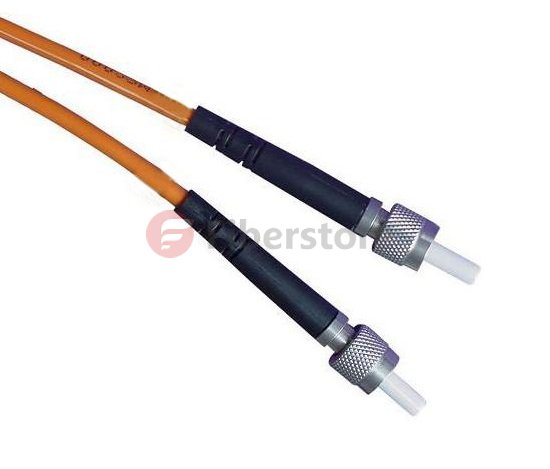In 1976, Corning developed 50/125μm by the graded-index multimode fiber and 1983 by Lucent Bell Labs developed 62.5/125μm graded-index multimode fiber, they are two larger amount of Multimode Fiber. The cladding diameter and mechanical properties of these two fibers are same, but different transmission characteristics. They can provide such as Ethernet, Token Ring and FDDI protocols specified in the standard distance required bandwidth, and it can be upgraded to Gb/s rate.
The new multimode fiber standard grades issued by ISO / IEC 11801, Multimode fiber is divided into four categories, OM1, OM2, OM3, OM4. OM1 and OM2 refer to traditional 62.5/125μm and 50/125μm multimode fiber. OM3 and OM4 refer to the new Gigabit 50/125μm multimode fiber.
62.5/125μm Graded-index Multimode fiber(OM1,OM2)
Common 62.5/125μm graded-index multimode fiber is the IEC-60793-2 fiber optic products specification Alb type. As the core diameter and a numerical aperture of 62.5/125μm fiber is greater, which has a strong anti-concentrating ability and bending characteristics, especially in the 20th century, before the mid-1990s, the lower the rate of the LAN, less demanding on the fiber bandwidth, thus making this fiber to obtain the most widely used, becomes 20 years between the mid-1980s to the mid-1990s mainstream products in most countries data communications fiber market. Belong OM1 and OM2 fiber types of Alb full power injection (OFL) bandwidth respectively 200/500MHz.km (850/1300nm) 500/500MHz.km (850/1300nm).
Now you can see the follow products about 62.5 Multimode Fiber
SMA905- SMA905 Duplex OM1 62.5/125 Dia2.5mm Fiber Patch Cable from Fiberstore
50/125μm graded-index multimode fiber(OM1,OM2)
Common 50/125μm OM2 Fiber graded-index multimode fiber is the IEC-60793-2 fiber optic products specification Ala.1 type. Historically, in order to reduce as much as possible the cost of the LAN system, widely used inexpensive LED as the light source, rather than expensive LD. Since the LED output power is low, the divergence angle is much larger than LD, while the core diameter and a numerical aperture of 50/125μm multimode fiber are relatively small, is not conducive to efficient coupling with the LED, as large core diameter and numerical aperture of 62.5/125μm (Alb class) fiber enables more light power coupled into the fiber link to, therefore, 50/125μm graded-index multimode fiber in the mid-90s as good as 62.5/125μm (Alb class) that is widely used fiber.
Since the 20th century, a local area network developed up to lGb / s rate, it didn’t meet the requirement 62.5/125μm OM1 Fiber bandwidth with LED light source. Compared with 62.5/125μm multimode fiber, 50/125μm multimode fiber core diameter and a numerical aperture smaller, 50/125μm gradient in the number of multi-mode fiber conduction mode refractive index of about 62.5/125μm multimode fiber conduction mode 1/2.5, thus effectively reducing the modal dispersion of a multimode optical fiber, such that the bandwidth is significantly increased production costs .50/125μm multimode optical fiber is reduced to about 1/3. So make it again been widely used. IEEE802.3z Gigabit Ethernet standard provides 50/125μm multimode and 62.5/125μm multimode fiber can be used as a transmission medium using Gigabit Ethernet. But for the new network is generally preferred 50/125μm multimode fiber. Belong OM1 and OM2 fiber types are Ala. 1 full power injection (OFL) bandwidth respectively 200/500MHz.km (850/1300nm) and 500/500MHz.km (850/1300nm)
Traditional OM1 and OM2 multimode fiber from the standard mode and design are based LED, as the operating wavelength of 850 nm, a low price VCSEL (Vertical Cavity Surface Emitting Laser) and the emergence of wide application, 850nm importance window increased. VCSEL can be lower than the price of long-wavelength lasers to improve network speed to the user. 50/125μm multimode fiber has a higher bandwidth 850nm window, low price VCSEL can support longer transmission distances for Gigabit Ethernet protocol, and the high rate support longer distances. With the improvement of network speed and size, modulation rates up to 10Gb/s short-wavelength VCSEL laser light sources become one of the high-speed network. Since the difference between the two light-emitting devices, optical fibers must transform itself to adapt to changes in light. In order to meet the needs of 10 Gb / s transfer rate, the International Organization for Standardization / International Electrotechnical Commission (ISO/IEC) and the Telecommunications Industry Alliance (TIA) joint drafting of a new generation of 50 μm core multimode fiber standard. ISO/IEC in the new multi-mode fiber grade they will develop a new generation of multi-mode fiber is zoned 0M3 category (IEC standard A1a.2)
OM4 fiber is optimized for the 50μm core multimode fiber, currently, the OM4 (IEC standard A1a.3) criteria is actually an upgraded version of an OM3 multimode fiber. Compared with standard OM3 OM4 fiber, fiber bandwidth indicators just do upgrade. That OM4 standards are made to improve the 850nm wavelength effective modal bandwidth (EMB) and the full bandwidth of the injection (OFL) compared to OM3 fiber.

